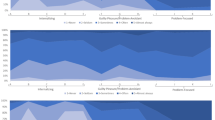Abstract
Emergency medical workers’ distress and recovery patterns after a mass shooting were related to their coping behaviors and routine daily activities. This longitudinal repeated measures study assessed 31 emergency medical workers’ psychological and psychosomatic symptoms self-rated for the weeks before, those just after, and one full month after the shooting. Coping behaviors and time in creative activities were related to increased acute distress; recovery was related to more time in constructive activities. Thinking about the incident was related to higher acute distress but better recovery on several SCL9OR scales. Exercise predicted recovery on Obsessive-Compulsive and Hostility scales. Studies evaluating emergency workers’ reactions to and recovery from critical incidents should use repeated measures designs, should assess short-term recovery, and should distinguish among symptoms.
Similar content being viewed by others
References
American College of Sports Medicine. (1991). Guidelines for Exercise Testing and Prescription. Philadelphia: Lea & Febiger.
Block, J. (1965). The challenge of response sets: Unconfounding meaning, acquiescence, and social desirability in the MMPI. New York: Appleton-Century-Crofts.
Brophy, C.J., Norvell, N.K., & Kiluk, D.J. (1988). An examination of the factor structure and convergent and discriminant validity of the SCL9OR in an outpatient clinic population. Journal of Personality Assessment, 52: 334–340.
Creamer, M., Burgess, P., & Pattison, P. (1990). Cognitive processing in post-trauma reactions: Some preliminary findings. Psychological Medicine, 20: 597–604.
Creamer, M., Burgess, P. & Pattison P. (1992). Reaction to trauma: A cognitive processing model. Journal of Abnormal Psychology, 101: 452–459.
Derogatis, L.R. (1992). The Symptom Check List-90-Revised: Administration, scoring, and procedures manual-II. Second Edition. Towson, MD: Clinical Psychometric Research.
Dinning, W.D., & Evans, R.G. (1977). Discriminant and convergent validity of the SCL-90 in psychiatric patients. Journal of Personality Assessment, 41: 304–310.
Dubbert, P.M. (1992). Exercise in behavioral medicine. Journal of Consulting and Clinical Psychology, 60: 613–618.
Durham, T.W., McCammon, S.L., & Allison, E.J, Jr. (1985). The psychological impact of disaster on rescue personnel. Annals of Emergency Medicine, 14: 664–668.
Folkman, S., & Lazarus, R.S. (1980). An analysis of coping in a middle-aged community sample. Journal of Health and Social Behavior, 21: 219–239.
Folkman, S., & Lazarus, R.S. (1985). If it changes it must be a process: Study of emotion and coping during three stages of a college examination. Journal of Personality and Social Psychology, 48: 150–170.
Folkman, S., Lazarus, R.S., Dunkel-Schetter, C, DeLongis, A., & Gruen, R.J. (1986). Dynamics of a stressful encounter: Cognitive appraisal, coping, and encounter outcomes. Journal of Personality and Social Psychology, 50: 992–1003.
Genest, M., Levine, J., Ramsden, V., & Swanson, R. (1990). The impact of providing help: Emergency workers and cardiopulmonary resuscitation attempts. Journal of Traumatic Stress, 3: 305–313.
Green, B.L. (1985). Overview and research recommendations. In National Institute of Mental Health, Role Stressors and supports for emergency workers, pp. 1–20.
Horowitz, M.J., Wilner, N., & Alvarez, W. (1979). Impact of Event Scale: A measure of subjective stress. Psychosomatic Medicine, 4: 209–218.
Jenkins, S.R. (1996). Social support and debriefing efficacy among emergency medical workers after a mass shooting incident. Journal of Social Behavior and Personality, 11, 477–492.
Jenkins, S.R. (In press). Emergency workers’ responses to death. Omega.
Jenkins, S.R. (1997). Emergency medical workers’ mass shooting incident stress and psychological recovery. Unpublished manuscript, University of North Texas.
Linden, W., Paulhus, D.L., & Dobson, K.S. (1986). Effects of response styles on the report of psychological and somatic distress. Journal of Consulting and Clinical Psychology, 54: 309–313.
McCammon, S.L., Durham, T.W., Allison, E.J., & Williamson, J.E. (1988). Emergency workers’ cognitive appraisal and coping with traumatic events. Journal of Traumatic Stress, 1: 353–372.
McFarlane, A.C. (1988). The longitudinal course of posttraumatic morbidity: The range of outcomes and their predictors. The Journal of Nervous and Mental Disease, 176: 30–39.
Nolen-Hoeksema, S, & Morrow, J. (1991). A prospective study of depression and posttraumatic stress symptoms after a natural disaster: The 1989 Loma Prieta earthquake. Journal of Personality and Social Psychology, 61: 115–121.
North, C. S., Smith, E. M, & Spitznagel, E. L. (1994). Posttraumatic stress disorder in survivors of a mass shooting. American Journal of Psychiatry, 151: 82–88.
Norvell, N., & Belles, D. (1993). Psychological and physical benefits of circuit weight training in law enforcement personnel. Journal of Consulting and Clinical Psychology, 61: 520–527.
Palmer, C.E. (1983). A note about paramedics’ strategies for dealing with death and dying. Journal of Occupational Psychology, 56: 83–86.
Parkes, K.R. (1980). Social desirability, defensiveness and self-report psychiatric inventory scores. Psychological Medicine, 10: 735–742.
Pendleton, M, Stotland, E., Spiers, P., & Kirsch, E. (1989). Stress and strain among police, firefighters, and government workers: A comparative analysis. Criminal Justice and Behavior, 16: 196–210.
Plante, T.G., & Rodin, J. (1990). Physical fitness and enhanced psychological health. Current Psychology: Research and Reviews, 9: 3–24.
Powell, B.J., & Penick, E.C. (1983). Psychological distress following a natural disaster: A one-year follow-up of 98 flood victims. Journal of Community Psychology, 11: 269–276.
Suter, S. (1986). Health psychophysiology: Mind-body interactions in Wellness and illness. Hillsdale, NJ: Lawrence Erlbaum.
Thoits, P.A. (1985). Self-labeling processes in mental illness: The role of emotional deviance. American Journal of Sociology, 91: 221–249.
Tinsley, H.E.A., & Eldredge, B.D. (1995). Psychological benefits of leisure participation: A taxonomy of leisure activities based on their need-gratifying properties. Journal of Counseling Psychology, 42: 123–132.
Author information
Authors and Affiliations
Rights and permissions
About this article
Cite this article
Jenkins, S.R. Coping, routine activities, and recovery from acute distress among emergency medical personnel after a mass shooting incident. Curr Psychol 16, 3–19 (1997). https://doi.org/10.1007/s12144-997-1012-1
Issue Date:
DOI: https://doi.org/10.1007/s12144-997-1012-1



